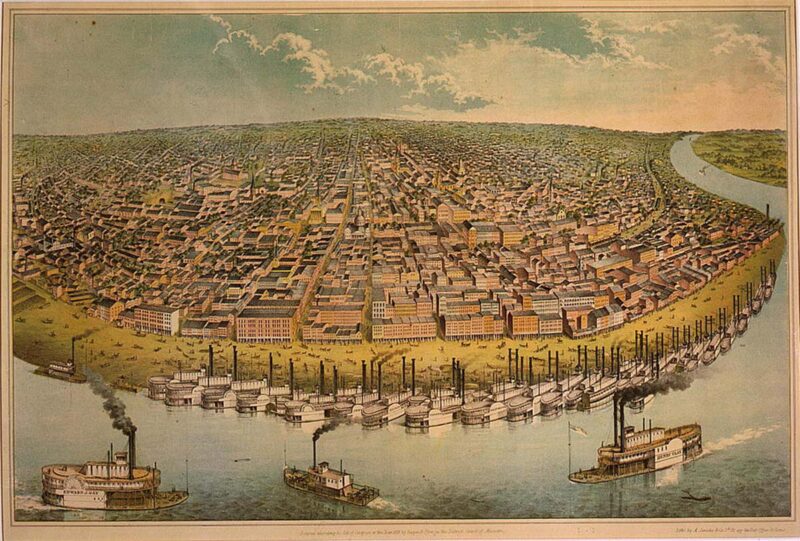
Share Post:
The Market Revolution refers to the dramatic transformation in American society from the late 18th century through the Civil War.
This period witnessed a shift from agrarian economies to industrial and commercial ones, radically changing social, economic, and cultural landscapes in the United States.
Table of Contents
ToggleTechnological Innovations

The Market Revolution was fueled by significant technological advancements that originated from the Industrial Revolution. The introduction of steam power revolutionized transportation with steamboats and railroads, drastically reducing travel time and costs.
Steamboats allowed for quicker upstream travel, while railroads connected distant regions, enhancing trade and mobility. Mechanization in industries, exemplified by textile mills and Eli Whitney’s cotton gin, drastically increased production efficiency.
The cotton gin, in particular, streamlined cotton processing, boosting the Southern economy.
The Transportation Revolution played a pivotal role in the Market Revolution. Improved roads, extensive canal systems, and the advent of railroads facilitated faster, cheaper, and more reliable movement of goods and people.
The Erie Canal, completed in 1825, linked the Great Lakes with the Atlantic Ocean, transforming New York City into a major commercial hub. The Baltimore & Ohio Railroad, the first long-distance rail line, demonstrated the potential of rail transport, spurring further railroad construction.
The Communications Revolution, epitomized by the telegraph, had profound effects on communication. Samuel Morse’s telegraph system enabled instant communication over long distances, transforming business operations, journalism, and personal correspondence.
This technological triad of steam power, improved transportation, and rapid communication interconnected various regions and sectors, setting the stage for the profound economic and social changes of the Market Revolution.
Economic Changes
The Market Revolution brought about sweeping economic changes, shifting the American economy from subsistence farming to commercial agriculture. Farmers began producing crops for profit rather than mere survival, spurred by increased market access and demand.
This shift was facilitated by transportation improvements, allowing farmers to reach distant markets. The rise of factories and industrial labor marked another significant economic transformation.
Artisanal labor declined as mass production techniques, such as the assembly line and interchangeable parts, took precedence. Factories employed large numbers of workers, leading to the growth of wage labor and changing the nature of work.
Banking and capital investment played crucial roles in supporting economic expansion. State-chartered banks proliferated, providing the necessary financial infrastructure for business growth.
European capital investment in American infrastructure, particularly in railroads and canals, further accelerated industrial development.
These economic changes not only boosted production and efficiency but also laid the groundwork for a more interconnected and dynamic national economy.
Social Changes

The Market Revolution induced significant social changes, particularly in labor organization and class structure. The emergence of factory labor and wage work replaced the traditional artisanal and agrarian modes of production.
This transition led to the deskilling of workers, as factory jobs required less specialized skills compared to artisanal crafts. The shift to factory labor altered social dynamics, as individuals now worked for wages rather than as independent producers.
Class stratification became more pronounced during this period, with the creation of a new middle class comprising professionals, merchants, and industrialists.
Urbanization accompanied industrialization, with cities like New York, Chicago, St. Louis, and Cincinnati experiencing rapid growth.
This urban expansion resulted in diverse, densely populated communities and new social challenges, including overcrowding and inadequate infrastructure.
Gender roles and family life underwent significant transformations. The distinction between public (male) and domestic (female) spheres became more pronounced, with men participating in the workforce while women were relegated to household duties.
This period also saw the rise of the “cult of domesticity,” which idealized women’s roles within the home. However, economic necessity often compelled women to engage in paid labor, particularly in textile mills and as domestic servants, challenging traditional gender norms.
Regional Impacts and the Cotton Kingdom
The Market Revolution had distinct regional impacts, notably the decline of Northern slavery and the rise of Southern plantations. In the North, industrialization and changing economic priorities led to the gradual abolition of slavery.
At the same time, the South became increasingly reliant on slave labor, driven by the cotton boom facilitated by the cotton gin.
The cotton gin’s efficiency in processing cotton made large-scale cotton cultivation profitable, entrenching slavery in the Southern economy.
The economic interdependence of the North and South became evident, with Northern industries relying heavily on Southern cotton for textile manufacturing. This interdependence highlighted the complexities of the American economy, where regional economic practices were deeply interconnected.
Slavery’s expansion in the South not only shaped regional economies but also had profound social and political implications, contributing to the tensions that eventually led to the Civil War.
The Role of the War of 1812 and Embargoes

The War of 1812 and subsequent embargoes played a critical role in the Market Revolution by disrupting trade with England. This disruption forced American industries to develop domestic manufacturing capabilities, fostering industrial growth.
The war highlighted the vulnerabilities of relying on foreign trade, prompting a shift towards self-sufficiency.
The period following the war saw boom and bust cycles, with the Panic of 1819 being a significant economic downturn. This financial crisis underscored the volatility of the emerging market economy and the need for a more stable financial system.
The economic challenges of this period spurred further innovation and investment, ultimately contributing to the resilience and expansion of the American economy.
The Bottom Line
The Market Revolution had a transformative impact on American society and economy, reshaping labor, class structures, gender roles, and regional dynamics.
Its long-term implications set the stage for modern industrial and economic practices, laying the groundwork for the United States’ emergence as a leading global economic power.






